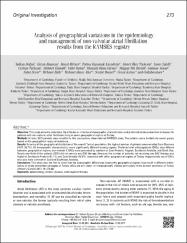Analysis of geographical variations in the epidemiology and management of non-valvular atrial fibrillation: results from the RAMSES registry

View/
Date
2017Author
Doğan, VolkanBaşaran, Özcan
Biteker, Murat
Karadeniz, Fatma Ozpamuk
Tekkesin, Ahmet Ilker
Cakilli, Yasin
Kirma, Cevat
Metadata
Show full item recordAbstract
Objective: This study aimed to determine the differences in terms of demographic characteristics and preferred stroke prevention strategies for patients with non-valvular atrial fibrillation living in seven geographical regions of Turkey. Methods: In total, 6273 patients were enrolled to this prospective, observational RAMSES study. The patients were divided into seven groups based on the geographical region of residence. Results: In terms of the geographical distribution of the overall Turkish population, the highest number of patients were enrolled from Marmara (1677, 26.7%). All demographic characteristics were significantly different among regions. Preferred oral anticoagulants (OACs) also differed between geographical regions; non-vitamin K OACs were preceded by warfarin in East Anatolia, Aegean, Southeast Anatolia, and Black Sea. Nearly one-third of the patients (28%) did not receive any OAC therapy. However, the number of patients not receiving any OAC therapy was higher in Southeast Anatolia (51.1%) and East Anatolia (46.8%) compared with other geographical regions of Turkey. Inappropriate use of OACs was also more common in East and Southeast Anatolia. Conclusion: This study was the first to show that the demographic differences among the geographical regions may result in different preferences of stroke prevention strategies in Turkey. OACs are still under-or inappropriately utilized, particularly in the eastern provinces of Turkey.

















